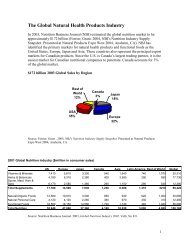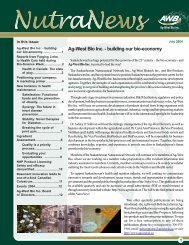Beyond Borders: Global biotechnology report 2010
Beyond Borders: Global biotechnology report 2010
Beyond Borders: Global biotechnology report 2010
You also want an ePaper? Increase the reach of your titles
YUMPU automatically turns print PDFs into web optimized ePapers that Google loves.
the pharmaceutical industry, as pharma<br />
companies are forced to rationalize R&D<br />
budgets and make tough decisions about<br />
their pipeline assets. Pharmaceutical<br />
companies — which have historically not<br />
done much out-licensing — will increasingly<br />
seek to out-license portions of their<br />
pipelines, or develop products using risksharing<br />
structures. (For more discussion<br />
of these trends, see this year’s <strong>Global</strong><br />
introduction article.)<br />
Even as public investors and VCs are raising<br />
the bar, there is broad recognition that a<br />
healthy emerging biotech sector is good<br />
for innovation and for the overall drug<br />
development ecosystem. As pharmaceutical<br />
companies access more and more of their<br />
drug candidates externally, they will need a<br />
vibrant community of innovative companies<br />
to take on the risk of early development. In<br />
last year’s <strong>Beyond</strong> borders, we highlighted<br />
one example of pharmaceutical companies<br />
cooperating to fund new enabling<br />
technologies through Enlight Biosciences.<br />
We expect to see other examples of “precompetitive<br />
collaboration,” but 2009 was<br />
marked more by the increasing prominence<br />
of corporate venture capital from several<br />
perspectives. In the past, corporate venture<br />
capital arms often invested as part of a<br />
broader collaboration arrangement or as<br />
a smaller player in a VC syndicate. It was<br />
also relatively uncommon to see more<br />
US yearly <strong>biotechnology</strong> financings, 1998–2009 (US$m)<br />
than one corporate investor in a particular<br />
transaction. In 2009, this changed<br />
markedly — a prominent example being<br />
Aileron Therapeutics, which raised US$40<br />
million in a round in which the venture<br />
arms of GlaxoSmithKline, Eli Lilly, Novartis<br />
and Roche all participated. In Europe, the<br />
importance of corporate venture capital<br />
was even more stark, with 8 of the top 10<br />
venture rounds having a corporate investor.<br />
Over these eight transactions, Novartis<br />
was an investor in six, including Opsana<br />
Therapeutics, where they invested alongside<br />
the Roche Venture Fund.<br />
Also prominent on the scene in 2009 was<br />
the Novartis Option Fund, which closed<br />
investment transactions with the likes of<br />
Avila Therapeutics, Elixir Pharmaceuticals,<br />
Forma Therapeutics, Heptares and Viamet<br />
Pharmaceuticals. In these deals, the<br />
Option Fund typically purchases an equity<br />
interest and obtains the right to license a<br />
particular program. Finally, in what may<br />
be the start of a trend, Eli Lilly announced<br />
it would spin out Lilly Ventures as an<br />
independent firm (with US$200 million)<br />
so that the venture arm could attract<br />
and retain partners who would otherwise<br />
not want to be bound by corporate<br />
compensation policies, and so that the<br />
partners would have the same profit<br />
interest as other syndicate investors.<br />
66 <strong>Beyond</strong> borders <strong>Global</strong> <strong>biotechnology</strong> <strong>report</strong> <strong>2010</strong><br />
United States<br />
Public companies<br />
At first blush, the rebound in financing<br />
for public companies in 2009 was<br />
remarkable, especially when layered against<br />
the backdrop of the gloom-and-doom<br />
predictions that existed at the beginning<br />
of the year. Total financing of public<br />
companies — including IPOs, follow-on public<br />
offerings, private investments in public<br />
equity (PIPEs) and debt deals — rebounded<br />
to an impressive US$13.5 billion from the<br />
anemic US$8.6 billion of 2008. However, as<br />
described in this year’s <strong>Global</strong> introduction<br />
article, the overall biotech funding story<br />
continues to be that the money raised<br />
is largely funding a very small cohort of<br />
companies. In 2009, two-thirds of the total<br />
was raised by just 19 companies — which is<br />
actually an improvement over 2008, when<br />
the same number of companies accounted<br />
for 75% of the (significantly smaller) fundraising<br />
total. Despite the fact that the<br />
market’s appetite for follow-on offerings<br />
and PIPEs improved in the second half of<br />
2009, the reality was that the companies<br />
raising the five highest amounts of capital<br />
accounted for between 44% (in the third<br />
quarter) and 78% (first quarter) of total<br />
funds raised in each quarter of 2009.<br />
2009 2008 2007 2006 2005 2004 2003 2002 2001 2000 1999 1998<br />
IPOs 697 6 1,238 944 626 1,618 448 456 208 4,997 685 260<br />
Follow-ons 5,165 1,715 2,494 5,114 3,952 2,846 2,825 838 1,695 14,964 3,680 500<br />
Other 7,617 6,832 12,195 10,953 6,788 8,964 8,306 5,242 3,635 9,987 2,969 787<br />
Venture 4,556 4,445 5,464 3,302 3,328 3,551 2,826 2,164 2,392 2,773 1,435 1,219<br />
Total 18,034 12,998 21,391 20,313 14,694 16,979 14,405 8,699 7,930 32,722 8,769 2,766<br />
Source: Ernst & Young, BioCentury, BioWorld and VentureSource<br />
Numbers may appear inconsistent because of rounding.








